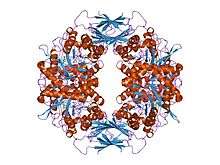Glycoside hydrolase family 39
| Glycosyl hydrolases family 39 | |||||||||
|---|---|---|---|---|---|---|---|---|---|
 crystal structure of beta-d-xylosidase from thermoanaerobacterium saccharolyticum, a family 39 glycoside hydrolase | |||||||||
| Identifiers | |||||||||
| Symbol | Glyco_hydro_39 | ||||||||
| Pfam | PF01229 | ||||||||
| Pfam clan | CL0058 | ||||||||
| InterPro | IPR000514 | ||||||||
| PROSITE | PDOC00787 | ||||||||
| SCOP | 1uhv | ||||||||
| SUPERFAMILY | 1uhv | ||||||||
| CAZy | GH39 | ||||||||
| |||||||||
In molecular biology, glycoside hydrolase family 39 is a family of glycoside hydrolases.
Glycoside hydrolases EC 3.2.1. are a widespread group of enzymes that hydrolyse the glycosidic bond between two or more carbohydrates, or between a carbohydrate and a non-carbohydrate moiety. A classification system for glycoside hydrolases, based on sequence similarity, has led to the definition of >100 different families.[1][2][3] This classification is available on the CAZy(http://www.cazy.org/GH1.html) web site,[4] and also discussed at CAZypedia, an online encyclopedia of carbohydrate active enzymes.[5]
Glycoside hydrolase family 39 CAZY GH_39 comprises enzymes with several known activities; alpha-L-iduronidase (EC 3.2.1.76); beta-xylosidase (EC 3.2.1.37).
The most highly conserved regions in these enzymes are located in their N-terminal sections. These contain a glutamic acid residue which, on the basis of similarities with other families of glycosyl hydrolases,[6] probably acts as the proton donor in their catalytic mechanism.
References
- ↑ Henrissat B, Callebaut I, Mornon JP, Fabrega S, Lehn P, Davies G (1995). "Conserved catalytic machinery and the prediction of a common fold for several families of glycosyl hydrolases". Proc. Natl. Acad. Sci. U.S.A. 92 (15): 7090–7094. doi:10.1073/pnas.92.15.7090. PMC 41477
 . PMID 7624375.
. PMID 7624375. - ↑ Henrissat B, Davies G (1995). "Structures and mechanisms of glycosyl hydrolases". Structure. 3 (9): 853–859. doi:10.1016/S0969-2126(01)00220-9. PMID 8535779.
- ↑ Bairoch, A. "Classification of glycosyl hydrolase families and index of glycosyl hydrolase entries in SWISS-PROT". 1999.
- ↑ Henrissat, B. and Coutinho P.M. "Carbohydrate-Active Enzymes server". 1999.
- ↑ CAZypedia, an online encyclopedia of carbohydrate-active enzymes.
- ↑ Henrissat B, Callebaut I, Fabrega S, Lehn P, Mornon JP, Davies G (July 1995). "Conserved catalytic machinery and the prediction of a common fold for several families of glycosyl hydrolases". Proc. Natl. Acad. Sci. U.S.A. 92 (15): 7090–4. doi:10.1073/pnas.92.15.7090. PMC 41477
 . PMID 7624375.
. PMID 7624375.
This article incorporates text from the public domain Pfam and InterPro IPR000514